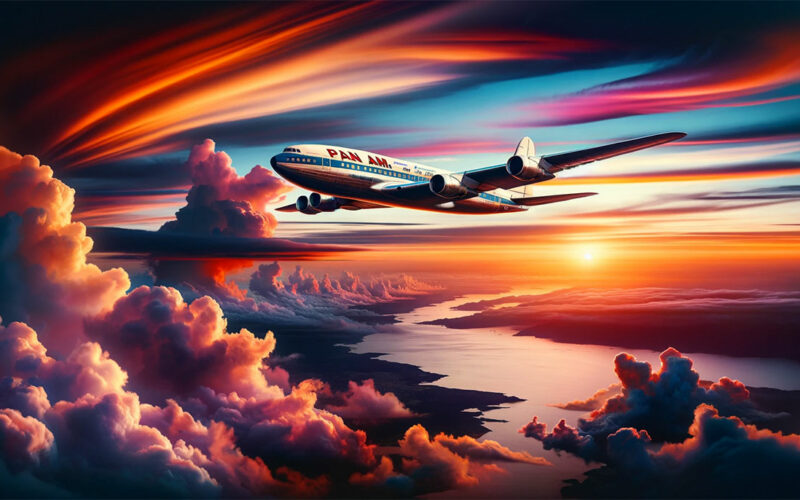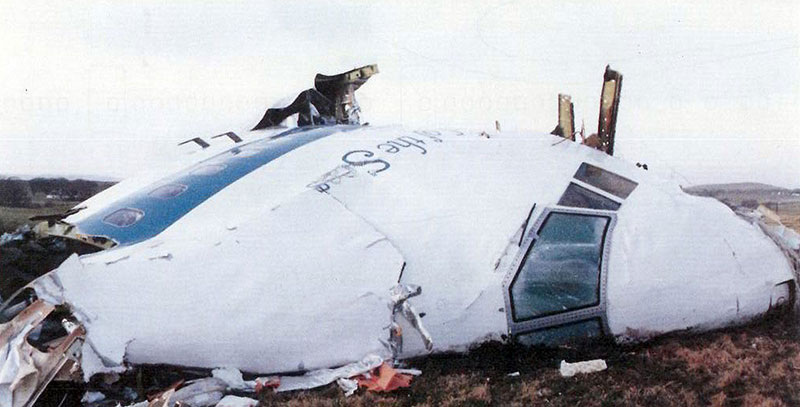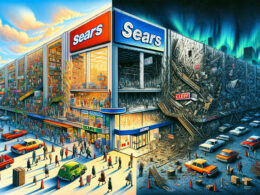What Happened to Pan Am? A Tale of Its Bankruptcy

So, picture this: it’s the early 20th century, and these folks have a wild idea—flying people across the oceans in these massive metal birds.
That’s Pan Am for you, a real pioneer in the game. They didn’t just dip their toes in; they went full cannonball into international flights during the jet age.
Pan Am wasn’t just about getting from A to B. They were trailblazers, dreamers, the kind of people who looked at the sky and saw runways.
This was the era of firsts—first across the Pacific, the Atlantic, you name it. And the world? It just got a whole lot smaller because of them.
Fast forward to the 1970s. If you thought Pan Am was just about getting you places, think again.
This was the golden age of air travel, and Pan Am was living it up. We’re talking luxury, baby—fancy meals, comfy seats, the whole shebang. Flying was an event, something you dressed up for.
But it wasn’t just about the glam. Pan Am was a big deal, culturally and economically.
They were connecting dots on the map, making the globe a village before that was even a thing. They were the wings beneath the world’s feet, and for a while there, they soared.
The Challenges and Downfall
Regulatory and Competitive Pressures

Okay, so not everything was smooth flying. The skies got a bit turbulent with the Airline Deregulation Act of 1978. The rules changed, and suddenly, the air was thick with competition, both domestic and international carriers wanting a piece of the pie.
Pan Am was like that cool, old school diner in a town suddenly flooded with flashy new restaurants. They had the charm, the history, but were they ready for the shake-up? It was a tough crowd, and the game was changing.
Financial Struggles
Now, let’s talk money, or rather, the lack of it. Fuel costs were skyrocketing—thank you, oil crisis—and Pan Am’s wallet was feeling the burn.
But it wasn’t just the fuel. Decisions were made, and let’s just say, not all of them were golden tickets.
There were some missteps, some stumbles in the dark. Hindsight’s 20/20, but in the moment, those financial mismanagement moves and poor strategic decisions hit hard.
Catastrophic Events and Public Image
Terrorism and Security
Okay, let’s get real. There was this one day that changed the game for Pan Am. The Lockerbie bombing. This wasn’t just any bad day, it was the bad day.
Suddenly, what happened to Pan Am wasn’t just about business moves or oil prices. It was about safety, trust, and lives lost.
The aftermath? It was like a punch to the gut. The world looked at Pan Am and saw vulnerability.
The airline that connected people was now a symbol of risk. Security? People started second-guessing. This wasn’t just an incident; it was a scar on Pan Am’s rep, one that didn’t fade.
Public Relations and Brand Damage
Trust is like glass, right? Once it’s cracked, good luck gluing it back together.
Pan Am’s brand, once the beacon of luxury and dreams, took a nosedive. It’s like the brand was walking the red carpet, and then suddenly, it tripped. Hard.
And the media? They were like paparazzi on a scandal. Every detail, every angle was under the spotlight. The decline in public trust and brand value wasn’t just news; it was the headline.
The Final Years and Bankruptcy
Desperate Measures
Alright, picture this: You’re in a sinking boat, and you’re tossing out everything, even your favorite stuff, just to stay afloat.
That was Pan Am in the final years. They were throwing out assets, trying to keep the lights on.
And then, in a Hail Mary move, they bought National Airlines. Was it a lifeline or an anchor? Spoiler: it wasn’t a lifeline.
The Inevitable End
All stories have an ending, and Pan Am’s was written in bankruptcy filings. The dream was over. The flights were grounded.
What happened to Pan Am?
It became a chapter in aviation history books.
Delta swooped in, picking up the pieces. It was like a phoenix rising from the ashes, but the phoenix was wearing Delta colors.
Pan Am’s assets, its routes, its legacy—they were passed on. But the name, the spirit, and those golden days? They took off into the sunset, leaving behind tales of what once was.
Legacy and Lessons Learned
Innovations and Contributions to Aviation
So, we’ve been chatting about what happened to Pan Am, but let’s not forget the cool stuff they did.
These folks were the real MVPs when it came to changing the game in international air travel. I mean, they made the world a smaller place way before the internet was even a thing.
Pan Am didn’t just fly planes; they were pioneers, pushing boundaries, and leaving a trail of stardust in the sky.
Their impact? It stuck like gum on a shoe. They shaped aviation culture, made flying cool, and left behind a legacy that’s still talked about.
They were the trendsetters, the trailblazers, the ones who dared to dream big.
Business Insights
Alright, so what’s the real tea? What can the big brains in business learn from the whole Pan Am saga?
Two words: adaptability and innovation.
The world’s like one of those fast-spinning rides at the fair, and if you’re not holding on tight and changing with it, you’re gonna fly right off.
Pan Am taught us that having foresight in business isn’t just nice; it’s a must. Strategic management isn’t just a fancy phrase; it’s the lifejacket that keeps companies afloat when the tide gets rough.
FAQ On What Happened To Pan Am
Why Did Pan Am Go Bankrupt?
Ah, the million-dollar question, right? So here’s the lowdown: Pan Am hit some seriously turbulent skies.
It’s like they were caught in a perfect storm of sky-high fuel prices, fierce competition post-airline deregulation, and some pretty dicey financial moves.
Throw in a few global crises, and their cash reserves started looking as thin as airplane coffee.
It all piled up until, well, bankruptcy was the only runway left.
How Did the Airline Deregulation Act Affect Pan Am?
Okay, imagine this: You’ve got a playground, and only a few kids are allowed to play on it. Then suddenly, everyone’s invited.
That’s kinda what happened to Pan Am after the Airline Deregulation Act in 1978.
They went from flying high with little competition to battling it out with a bunch of new and hungry airlines.
It was a dogfight for routes and customers, and Pan Am, well, they got outmaneuvered.
What Role Did the Oil Crisis Play in Pan Am’s Downfall?
Remember when gas prices went nuts in the ’70s? Well, airlines felt that sting big time, Pan Am included.
They were guzzling jet fuel like there was no tomorrow, and when those prices shot up, their budget got all kinds of busted. It was like trying to fill a pool with a leak in the bottom — just couldn’t keep up.
Was Pan Am Affected by Terrorism?

Totally, and it was brutal. The Lockerbie bombing in 1988 was like a punch in the gut.
That tragedy slapped a huge question mark over Pan Am’s safety record, and public trust took a nosedive. When folks are scared to fly with you, you know you’ve hit a rough patch.
How Did Pan Am’s Public Image Contribute to Its Downfall?
Brand image is everything, right? Pan Am used to be like the Gucci of the skies. But post-Lockerbie, their rep took a hit.
It’s tough to sell tickets when your name’s tangled up with tragedy. Plus, their financial woes weren’t exactly secret, and that didn’t help the old confidence either.
Why Did Pan Am Sell Its Pacific Division?
Cash, or the lack of it, that’s why. Pan Am was bleeding money, and they needed a tourniquet, fast.
Selling their Pacific division to United Airlines was like hocking a prized guitar to keep the lights on. It helped short-term, but it also meant losing a chunk of their network and identity.
What Happened with the National Airlines Acquisition?
Oh boy, talk about a deal gone sour. Pan Am thought snagging National Airlines would be a power move, but it was more like stepping on a rake.
Integration was a hot mess, and the costs? Sky-high. Plus, the timing was lousy, what with all the industry chaos. Not their brightest moment, for sure.
How Did the Lockerbie Bombing Affect Pan Am’s Security Image?
One word: catastrophically. Security is the bedrock of any airline, and after Lockerbie, people were eyeing Pan Am like a rickety rollercoaster.
Their security image was in shambles, and restoring confidence is a long-haul flight, not a quick hop.
What Happened in the Final Days Leading Up to Pan Am’s Bankruptcy?
It was like watching a juggernaut running out of steam. Pan Am was scrambling, selling off assets, cutting costs — you name it.
But the debts were like quicksand, and no matter how hard they struggled, down they went. In the end, bankruptcy was the only escape hatch left.
Who Bought Pan Am’s Remaining Assets?
When the final curtain fell, Delta Air Lines swooped in like a knight in shining armor — or a savvy business, take your pick.
They snagged Pan Am’s remaining goodies: routes, gates, and the Pan Am brand itself. For Delta, it was a pretty sweet deal, like picking out the best pieces from a treasure chest.
Conclusion On What Happened To Pan Am
Alright, let’s take a step back and soak it all in. Pan Am wasn’t just an airline; it was like the heartbeat of an era. When we dive into what happened to Pan Am, we’re not just leafing through a dusty history book; we’re reliving the chapters of an epic story. Its name was like a VIP pass to the world, a golden ticket to the skies.
And hey, it’s not just about nostalgia. Pan Am’s story is like a treasure map for the whole aviation industry. Every up and down, every triumph, and mishap is a lesson etched in the clouds. They were the dreamers who showed us that the sky wasn’t the limit; it was just the beginning.
So, where do we go from here? Pan Am might have closed its cabin doors, but the journey didn’t end there. Modern airlines are flying on the wings of what Pan Am started. We’re talking about innovation, customer service, and dreaming big—real big.
Pan Am’s legacy is like the North Star for today’s airlines. It’s about being bold but also wise, flashy but also smart. The future of air travel? It’s looking brighter than a jet engine, and that’s partly thanks to what Pan Am left behind.
If you liked this article about what happened to Pan Am, you should check out this article about what happened to MoviePass.
There are also similar articles discussing what happened to Quiznos, what happened to Sears, what happened to BlackBerry, and what happened to Pontiac.
And let’s not forget about articles on what happened to Circuit City, what happened to American Apparel, startup failure, and failed startups.
- Simplifying Video Editing: Creative Apps Like Kapwing - May 3, 2024
- Healthcare software: Exploring 10 essential types and their benefits - May 3, 2024
- The Best CSS Preprocessors for Developers - May 3, 2024








